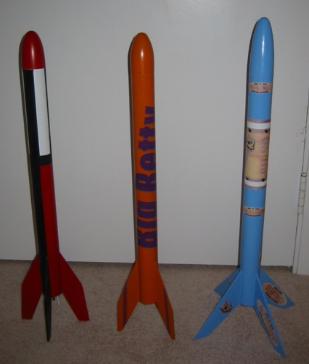| Construction Rating: | starstarstarstarstar_border |
| Flight Rating: | starstarstarstarstar |
| Overall Rating: | starstarstarstarstar_border |
| Diameter: | 1.64 inches |
| Length: | 24.00 inches |
| Manufacturer: | Estes  |
| Skill Level: | 1 |
| Style: | Sport |

Background:
This spring I ran a build session for faculty kids at the school where I teach. I ended up using the Quest Bright Hawk for the 7-9 year olds and the Quest Big Betty for the 10-12 year olds. After the build session, I began thinking about the types of rockets that would make great first builds for a budding rocketeer. I wanted to select rockets to compare that had the following in common:
- BT-60 body tube
- Parachute recovery
- Balsa fins
- Engine hook motor retention
- Reasonable Price
- Stable flight performance
- A rocket that can fly on small athletic fields and can be viewed in all aspects of flight. In other words, no Alphas, Wizards, or Vikings.
I ended up selecting 3 rockets that fit these criteria. The Estes Big Bertha, the Quest Big Betty, and the Fliskits Rhino.
Click Here for the Comparison Article.
Construction:
The Big Bertha is your standard Estes Skill Level 1 bird. The instructions are adequate, and the parts are usually average to above average in quality except for the shock cord (too short). The motor mount is easy to construct, and the engine hook is simple to add to the motor mount. What is nice about the Big Bertha is the length of the motor mount. This reduces the overall amount of the body tube that needs to be pressurized at deployment time. It also makes it easier for clumsy hands to handle. The fins are die cut and require minimal sanding to get a good finish. Remember, I tried to build the Big Bertha as a beginner would. Using the double glue method, it is easy to get the fins on the body tube. I added fillets to the fins and added the very long launch lug to the body tube. As is the case with many Estes kits, the parachutes may arrive already with shroud lines attached. All I needed to do was add the shock cord using the tri-fold method, attach the parachute and attach the shock cord to the nose cone.
Finishing:
Finishing consisted of priming and Fill-N-Finish. I then painted my Big Bertha with a 60’s design. Had I finished the rocket as a skill level one bird, I would simply have given it a solid coating of black and put on the one simple self-stick decal sheet. Since this was the Big Bertha, a classic, I did give myself the liberty of designing it my way, rather than the simple black.
Construction Rating: 4 out of 5
Flight:
I have flown my Big Bertha on B6-4s, C6-5s and even a D21-7. This bird always turns in a solid performance flight after flight. It is very easy to prep and pack the parachute. With the size of the rocket and the big swept back fins, the Big Bertha can be a great demonstration model to be enjoyed in all stages of flight and recovery. This is probably one of the reasons why it is a classic.
Flight Rating: 5 out of 5
Overall Rating: 4 out of 5
Other Reviews
- Estes Big Bertha By Bill Eichelberger
Brief: Everybody's favorite prom date, the Estes Big Bertha, is a rocket that seems to wind up in every fleet at one time or another. While there are a lot of other rockets in her size range that equal her low, slow, and always stable flights, there's something to be said for building and flying the original. Bertha's getting a little long in the tooth these days and in need of an ...
- Estes Big Bertha By Paul Gray
(by Paul Gray) Background The Big Bertha is a classic rocket built and flown by thousands of people around the world since 1965. Its was designed to have a rather impressive size and to develop the skills of people who are advancing themselves further in the hobby of model rocketry. Because of its size and performance, it is a great rocket to fly on a football field on C motors, ...
 |
 |
Flights
 |
 |
J.W.P. (January 1, 2001)
D.T.H. (January 1, 2001)
P.D.M. (May 1, 2001)
D.P. (July 1, 2001)
D.H. (October 2, 2001)
M.B.H (October 11, 2001)
M.C.L (December 26, 2001)
B.A. (March 24, 2002)
J.R. (July 30, 2002)
D.W. (April 5, 2003)
 |
 |
K.R.J. (November 1, 2000)